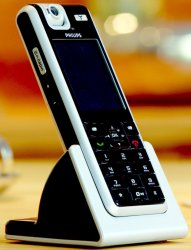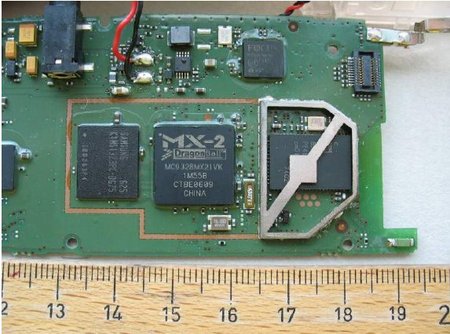New Philips WiFi videophone runs Linux
Jan 18, 2007 — by LinuxDevices Staff — from the LinuxDevices Archive — 10 views Philips Consumer Electronics has registered a Linux-powered WiFi videophone with the FCC, for possible U.S. distribution. The Visiophone VP6000 and its earphone-jack- and TV-out-equipped sibling, the VP6500, run Linux on an ARM9-based Freescale i.MX21 processor, and feature vendor-initiated… firmware updates.
Philips Consumer Electronics has registered a Linux-powered WiFi videophone with the FCC, for possible U.S. distribution. The Visiophone VP6000 and its earphone-jack- and TV-out-equipped sibling, the VP6500, run Linux on an ARM9-based Freescale i.MX21 processor, and feature vendor-initiated… firmware updates.
 The company's earlier VP5x00 videophone (pictured at right) also ran Linux.
The company's earlier VP5x00 videophone (pictured at right) also ran Linux.
As with the VP5x00, the VP6x00 cannot function as a videophone without mobile carrier support, according to the draft manual submitted to the FCC. Thus, the device appears to be designed for distribution by broadband network operators, as part of a videophone services contract.
Philips's FCC registration materials for the Visiophone VP6x00 include test results suggesting that the device will support 802.11b/g WiFi and Bluetooth. The materials also include a draft user manual suggesting the device will support “802.11i” (WPA2 security extensions) and “802.11e” quality-of-service (QoS) enhancements.
The 32-page draft user manual suggests that the VP6x00 phones have a limited feature set, possibly to reduce operator support costs. However, the phone does have a few Linux- and Qtopia-like features, such as a user-customizable themes.
One of the more interesting features from a device maker's point of view is an automatic “push” software update capability. The update “typically takes place only at night,” according to the draft manual, and “only if you are not using the phone.” It takes about three minutes.
Another interesting feature is a camera that rotates 240 degrees. A sensor detects the VGA-resolution CMOS sensor's orientation, and flips the image as needed.
The VP6500 model adds a small sideflap (shown below) that covers a headphone jack and TV out jack for CIF (352 x 288) video.

The Philips VP6500's earphone and TV-out ports
What's under the hood?
The VP6x00 is based on a Freescale Dragon Ball i.MX21 processor (MC9328MX21VK). The processor integrates an ARM9 core, clocked between 266 and 400 MHz.

Inside the Philips VP6500
(Click to enlarge slightly)
Additional features and specifications listed in the draft user manual include:
- 2.2-inch QCIF+ (176 x 220) TFT LCD with 65k colors and progressive backlight
- VGA (640 x 480) CMOS camera with 1.6x digital zoom and brightness control
- VP6500 can send audio and CIF/QCIF/SubQCIF video to TV
- Voice-only calls
- Caller name and ID
- Ring profiles
- 15 polyphone ringer melodies,
- Emergency call feature when keypad locked
- UI can be customized with themes, colors, wallpaper
- 500 contacts
- Fotocall (picture of caller displayed)
- History of 50 each dialed, received, missed calls
- 802.11b/g/e/i
- Integrated antenna
- WiFi signal strength indicator
- WEP-WAP-WAP2
- 5.3 x 1.9 x 0.9 inches (134 x 49 x 24 mm)
- 5.9 ounces (168 gm)
- Consumes 3.5 Watts during a video call
- Consumes only 360 mW when fully charged and resting on the charger
The VP6x00 runs on a pair of rechargeable NiMH AA batteries, and comes with a recharging cradle and power supply unit. The VP6500 also comes with headphones and a TV-out cable.
Availability
No availability details for the Philips Visiophone VP6000 and VP6500 are currently available.
This article was originally published on LinuxDevices.com and has been donated to the open source community by QuinStreet Inc. Please visit LinuxToday.com for up-to-date news and articles about Linux and open source.